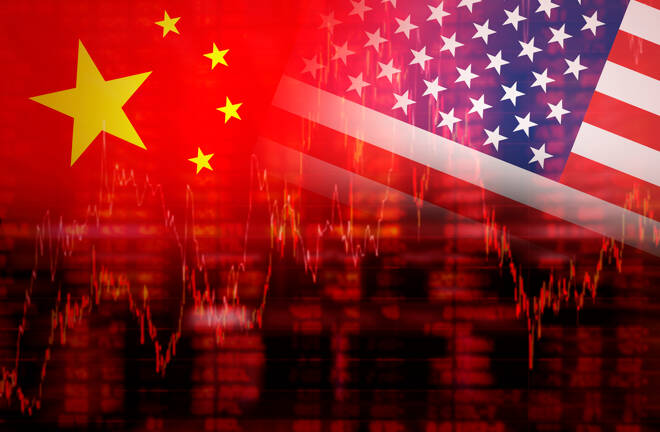Advertisement
Advertisement
China Acts on Jobs as Deflation, Tariffs Threaten 2025 Growth Target
By:
Key Points:
- Beijing unveils job stability measures as falling producer prices highlight deepening deflation risks.
- Caixin PMI data show continued job losses, underscoring fragile domestic demand and weak consumer confidence.
- Optimism over trade talks and new stimulus lifted the CSI 300 and Shanghai Composite in early July.
Economic Headwinds Trigger Beijing Policy Response
Recent economic indicators from China have fueled concerns about labor market conditions, crucial for Beijing’s goal to transition toward a consumption-driven economy.
June’s Caixin private sector PMIs revealed a continued fall in jobs. Waning overseas demand has fueled price pressures amid intensifying domestic competition, forcing firms to manage costs. Consumer price inflation and producer price trends for June also painted a grim demand backdrop.
While consumer prices rose 0.1% year-on-year (YoY) in June, prices fell 0.1% month-on-month, pointing to ongoing deflationary pressures. Significantly, producer prices fell 3.6% YoY in June, steeper than May’s 3.3% decline.
An accelerated fall in producer prices underscored the effects of price wars amid the increasing competition for domestic orders to counter falling overseas demand. US trade policies may exacerbate profit margin woes, potentially further weakening the labor market.
A deteriorating labor market would likely affect consumer sentiment, impacting private consumption. These trends may limit the effectiveness of Beijing’s previous stimulus measures aimed at boosting household spending.
On Wednesday, July 9, CN Wire reported policy pledges from Beijing targeting the labor market, stating:
“China to set up policy support for job stability to expand job-stability loans and streamline access through Gov-bank cooperation. To raise the unemployment insurance refund ratio for firms. To expand the scope of social insurance subsidies.’
The latest pledge to tackle job stability could be crucial given Beijing’s 5% GDP growth target for 2025.
Economists Raise Red Flags on China’s Economic Trajectory
East Asia Econ, a research service specializing in the markets and macro of China, Japan, Korea, and Taiwan, remarked on recent Chinese data. In response to the Caixin Services PMI, the platform stated:
“In the Caixin Services PMI, like the official version, both data and anecdotes are weak. Staffing levels were lowered in June… linked to a slowdown in new order growth and concerns over costs, and intense market competition, led to selling prices being cut at the sharpest pace since April 2022.”
East Asia Econ’s assessment of June’s inflation and producer price numbers was no better. The research firm stated:
“Deflation is deepening, which for PPI is broad-based. Core CPI is more stable, but that’s partly due to a rise in “other” prices. Headline CPI is lower on food prices, which have started dropping again.”
Deflation reflects low demand, underscoring the need for Beijing to address labor market issues to boost consumption. However, US tariffs on Chinese goods may continue to impact profit margins, labor market conditions, and consumer sentiment.
Analysts Forecast B30% to 60% US Tariff on Chinese Goods
United Overseas Bank reportedly expects the US-China tariff rate to settle between 30% and 60%. CN Wire reported:
“They forecast that the eventual U.S. tariff rate on Chinese imports could range between 30% and 60%. The established communication channels between the two nations are likely to lower the risk of negotiation breakdowns. The anticipated deal would likely include commitments from China to reduce its trade surplus with the U.S. by increasing imports and addressing export control issues.”
US-China trade talks could resume in August, with US Commerce Secretary Howard Lutnick reportedly stating that a US delegation will meet with Chinese officials to hold consultations on trade issues. Trade talks could be crucial as the US administration targets demand for Chinese goods by imposing punitive levies on transshipments from Asia.
The imposition of 30-60% tariffs on Chinese imports, alongside US levies on transshipments could undermine Beijing’s 2025 growth ambitions. This week, the US introduced a 32% tariff on Indonesia after introducing a 40% tariff on transshipments from Vietnam, signaling a potential US proxy trade war with China.
China’s exports to the US tumbled 43% year-on-year in May, while total exports increased by 4.8%. Notably, Chinese exports to Indonesia and Vietnam soared 25% and 30% (YoY), respectively, suggesting rerouting to dodge US tariffs.
Mainland China Advance Despite Economic Headwinds
Despite mounting tariff concerns, hopes for a breakthrough in trade talks and policy support lifted investor sentiment in Mainland markets. The CSI 300 and Shanghai Composite Index are up 1.41% and 1.4%, respectively, in July.
In contrast, the Hang Seng Index is down 0.72% as investors lock in profits from the first half of 2025. Year-to-date (YTD), the Hang Seng Index is up 19.14%, while the CSI 300 and Shanghai Composite Index trail, with YTD gains of 1.44% and 4.22%, respectively. The Nasdaq Composite Index outperforms Chinese indices in YTD performances, climbing 6.73%.
Outlook
US-China trade developments remain crucial as investors consider next month’s talks and the latest round of tariffs, targeting transshipments. Easing tensions and progress toward removing tariffs and stimulus from Beijing may fuel demand for Mainland and Hong Kong-listed stocks. Conversely, breaches of the US-China trade agreement to ease export restrictions could impact sentiment.
Follow our coverage as US-China tech tensions reshape global markets and consult our economic calendar.
About the Author
Bob Masonauthor
With over 28 years of experience in the financial industry, Bob has worked with various global rating agencies and multinational banks. Currently he is covering currencies, commodities, alternative asset classes and global equities, focusing mostly on European and Asian markets.
Advertisement
